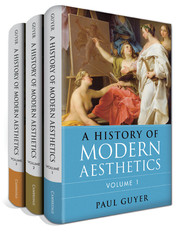Book contents
- Volume 1 The Eighteenth Century
- Volume 2 The Nineteenth Century
- Frontmatter
- Contents
- Acknowledgments
- Introduction
- Part One German Aesthetics in the First Half of the Nineteenth Century
- Part Two (Mostly) British Aesthetics in the Second Half of the Nineteenth Century
- Part Three German Aesthetics in the Second Half of the Nineteenth Century
- 8 In the Shadow of Schopenhauer
- 9 Neo-Kantian Aesthetics
- 10 Psychological Aesthetics
- Bibliography
- Index
- Volume 3 The Twentieth Century
- References
8 - In the Shadow of Schopenhauer
from Part Three - German Aesthetics in the Second Half of the Nineteenth Century
Published online by Cambridge University Press: 05 June 2015
- Volume 1 The Eighteenth Century
- Volume 2 The Nineteenth Century
- Frontmatter
- Contents
- Acknowledgments
- Introduction
- Part One German Aesthetics in the First Half of the Nineteenth Century
- Part Two (Mostly) British Aesthetics in the Second Half of the Nineteenth Century
- Part Three German Aesthetics in the Second Half of the Nineteenth Century
- 8 In the Shadow of Schopenhauer
- 9 Neo-Kantian Aesthetics
- 10 Psychological Aesthetics
- Bibliography
- Index
- Volume 3 The Twentieth Century
- References
Summary
In Part One of this volume, we saw how Schelling cast a large shadow over much thought about art both within and beyond Germany in the first decades of the nineteenth century, and that Hegel then cast an equally large shadow, especially on aesthetics in the German academy, in the three decades following his death. In the later years of that period, especially in the time between 1848 and his own death in 1860, Schopenhauer’s star began to rise. Following our discussion of British aesthetics from Ruskin to Bosanquet, we now return to the German scene to consider the influence of Schopenhauer on a new generation of aestheticians. Friedrich Nietzsche will be our primary subject, but we will also touch upon the aesthetic theory of Eduard von Hartmann. In the subsequent two chapters of this volume, we will examine the reviving influence of Kant, first among philosophers who considered themselves to be Neo-Kantians – although the most self-avowedly Neo-Kantian among them did not in fact revive Kant’s concept of free play – and then among a group of philosophers, all German-influenced although not all German, who did not think of themselves as Neo-Kantians but some of whom did revive Kant’s concept of play. Among this group, some, such as Herbert Spencer, revived the concept of play; others, such as Theodor Lipps, opposed the concept of empathy to it; and some, such as Karl Groos, tried to find room for both notions. But among all the philosophers to be considered in this part, it was probably Wilhelm Dilthey, an unorthodox Neo-Kantian who was also deeply influenced by Friedrich Schleiermacher, who developed the most comprehensive view of aesthetic experience, synthesizing, as Schleiermacher had before him, the aesthetics of truth, the aesthetics of feeling, and the aesthetics of play.
- Type
- Chapter
- Information
- A History of Modern Aesthetics , pp. 299 - 324Publisher: Cambridge University PressPrint publication year: 2014



